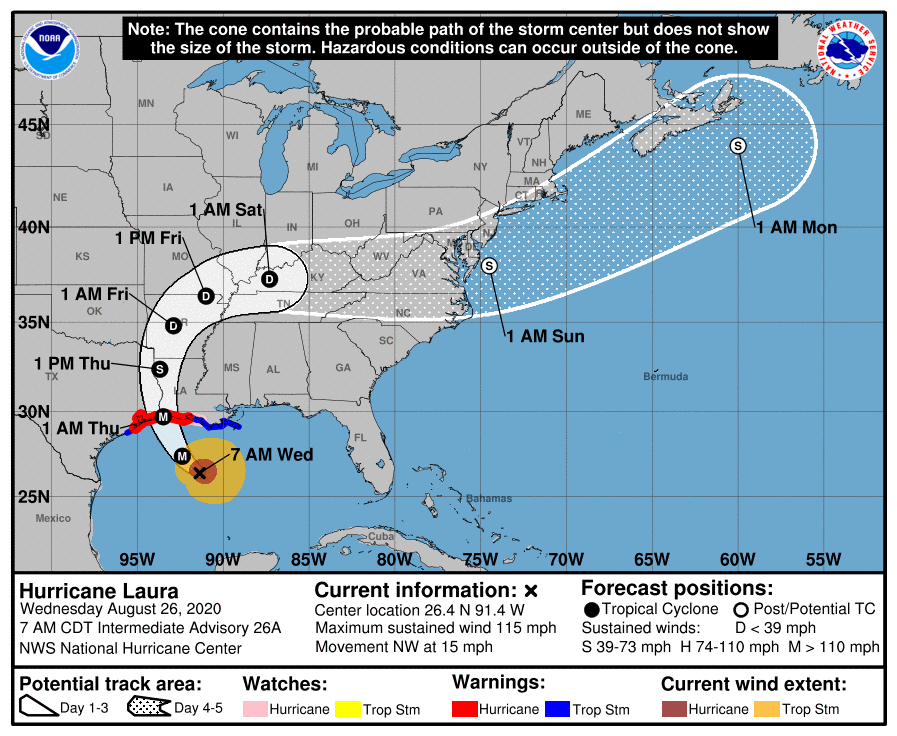Gulf Coast residents are waking up to a nightmare on Wednesday. Hurricane Laura has ballooned in size and strength, becoming the Atlantic’s first major hurricane of the season. The storm is forecast to keep intensifying up until landfall and is poised to be a massively destructive Category 4.
Laura underwent a phase of rapid intensification over the past 24 hours. After strafing Cuba and other parts of the Caribbean, the storm emerged over the Gulf of Mexico’s abnormally warm waters and began to ramp up. Over that period, wind speeds have risen from 70 mph (112 km/h) (strong tropical storm strength) to at least 185 km/h, making Laura a major Category 3 hurricane. Rapid intensification occurs when a storm’s wind speeds increase at least 56 km/h in a 24-hour period, and Hurricane Laura has done that and then some.
But the storm isn’t done yet. Warm waters will continue to feed the storm with the moisture it needs to keep building up. The National Hurricane Centre now predicts Laura will be a Category 4 storm at landfall late on Wednesday or early on Thursday with winds of roughly 209 km/h. Storm surge forecasts are also up. Some areas on the Texas-Louisiana coast are expecting to see up to 4.5 metres of surge depending on when the storm arrives, since high tide can influence how high the water gets (as does sea level rise).
Evacuations are already underway in the area, but if you live there and need a little extra incentive to find a way out, here’s how the NHC refers to Category 4 damage (emphasis added):
Catastrophic damage will occur: Well-built framed homes can sustain severe damage with loss of most of the roof structure and/or some exterior walls. Most trees will be snapped or uprooted and power poles downed. Fallen trees and power poles will isolate residential areas. Power outages will last weeks to possibly months. Most of the area will be uninhabitable for weeks or months.
If you need even more incentive to leave, the last Category 4 hurricane to make U.S. landfall was Hurricane Harvey in 2018. The issues with Harvey were more rain-related, but you get the point. Hurricanes are nothing to mess with, but something on the scale of Laura has the potential to be particularly deadly given the power it packs.

One of the areas most at-risk from Laura is Port Arthur, Texas, an area that was also hard hit by Harvey. More than 80% of the city’s buildings were damaged by that storm. Now, it’s in the bullseye again. The largest refinery in the U.S. is located there and has been shuttered as Laura approaches. The city of 54,000 is under an evacuation order and is providing buses to help residents without other means to leave.
Cramming people into enclosed spaces with close contact in the middle of a pandemic might seem like a bad idea, but then that should give you a sense of how dangerous the situation is with a storm bearing down. The fact that the coronavirus outbreak has lingered due to a bumbling federal response was always going to complicate what is becoming an exceptional hurricane season, but now here we are.
The situation shows the way that disasters are piling on top of one another. People have flocked to the Gulf Coast for decades, creating a huge swath of vulnerability right at a time when climate change makes living in the region more unsafe. Sea level rise and more powerful storms have combined to pose an ever-greater threat. Increasingly weak governance at the federal and — especially in Texas’ case — the state level mean residents are less prepared for disasters and have a weaker safety net when they do hit.
In Port Arthur’s cast, the city is stuck in what the Texas Observer calls “disaster recovery limbo” and has a poverty rate nearly three times the national average. As it’s currently forecasted, Laura will only set people living there back further.
